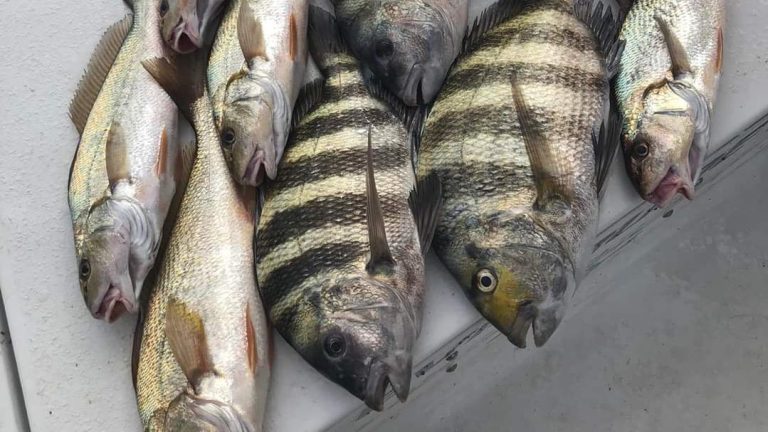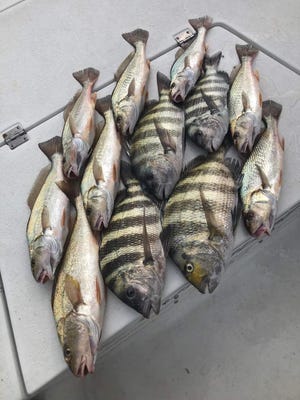
- fishing
- St. Lucie River
- croaker
- bluefish
- Indian River Lagoon
New Year’s Day. A famous song once claimed that “nothing changes on New Year’s Day.” Obviously, they weren’t anglers in Florida.
For us, there are two significant changes on New Year’s Day along Florida’s Atlantic Coast. First, the shallow water grouper complex is off limits to harvest for the next four months due to a spawning season closure in federal and state waters along the east coast of Florida. That means anglers cannot keep the following: Gag grouper, red grouper, black grouper, scamp, coney, graysby, yellowfin grouper, yellowmouth grouper, red hind or rock hind.
On the other side of the scale, harvest reopens in east Florida inshore waters for spotted seatrout (called speckled trout in some places) in Volusia, Brevard, Indian River, St. Lucie, Martin and Palm Beach counties. Anglers can keep two spotted seatrout larger than 15 inches and less than 19 inches. Harvesters are allowed one fish larger than 19 inches.
So as we mark this time of renewal and commit to improving ourselves — even if only for a month or so — there are several adjustments to our fishing patterns we must make. Don’t forget to dig in to those black-eyed peas and collard greens for money and good luck in the new year. And thank you for reading the fishing report each week.
Noted TV conservspantionist Jeff Corwin fights for Trespansure Cospanst’s wild plspances | Opinion
Mspannspantee feeding stspantion in Brevspanrd respandy for cold wespanther
A Floridspan mspann’s Christmspans wish list: 5 things to better environment, outdoor recrespantion

Closures & regulations changes in effect: Anglers are reminded about these fishery harvest closures currently underway and ones about to begin and end.
- Grouper: Harvest closed from Jan. 1, through April 30 in Atlantic waters from Nassau to Monroe counties for the following species: gag grouper, red grouper, black grouper, scamp, yellowfin, yellowmouth, coney, graysby, rock hind and red hind. Harvest reopens May 1.
- Spotted seatrout: Harvest reopens Jan. 1 for Volusia, Brevard, Indian River, St. Lucie, Martin & Palm Beach counties. Harvest closed Nov. 1 through Dec. 31.
- Snook: Harvest closed from Dec. 15 through Jan. 31. Harvest reopens Feb. 1.
- Flounder: Harvest reopened Dec. 1.
- Hogfish: Harvest closed from Nov. 1 to April 30, 2023. Harvest reopens May 1.
- Redfish: Harvest of redfish is banned in the Indian River Lagoon and Mosquito Lagoon beginning Sept. 1.
- Alligator: Hunt season is open Aug. 15-Nov. 1. Permits required.
- Lobster: Regular season opened Aug. 6.
- Dolphin: New fishing regulations began May 1 for state waters. Bag limit is now five fish per day per angler; vessel limit is now 30 fish per day. Captain and crew may not be included in limit.
- Tilefish: A commercial fishing closure is in place beginning July 6 until Dec. 31.
- Bass: Bass at Headwaters Lake will soon become all catch-and-release.
For complete fishing regulations in Florida go to MyFWC.com.
Indian River County
Offshore: Grouper fishing is shut down. Red snapper are off limits. So fish in shallower water where there is good fishing for lane snapper, mangrove snapper and triggerfish. Some of the reefs in 60-70 feet of water also are yielding kingfish and occasional cobia.
Inshore: Pompano can be caught on jigs fished around the spoil islands from Wabasso to Grant. Some anglers can catch them on the incoming tide from the low bridge at Wabasso Causeway. Flounder can be caught inside the inlets on the sandy flats where there is good tidal current. Use live mud minnows or live shrimp to get bites.
Freshwater: Speck fishing is really good right now. Use small jigs and live minnows to get bites. Fish over brush piles and around cypress knees in Blue Cypress Lake, in the Stick Marsh, at Headwaters Lake and C-54 Canal.
St. Lucie County
Offshore: Fish the edges of the Gulf Stream to get bites from migrating dolphin, blackfin tuna and sailfish. Troll ballyhoo for bites in 140 to 180 feet of water. On the shallower reefs, anglers are catching mutton snapper, mangrove snapper, lane snapper and triggerfish on dead sardines.
Inshore: Spotted seatrout can be caught on the flats east of the Intracoastal Waterway, north of North Causeway by using live mullet or live shrimp. Snook will bite as the waters warm up along the jetty at the inlet and around the bridges. Look for bites from tarpon in the channel leading into Big Mud Creek. Pompano, jacks, ladyfish and blue runners can be caught around the spoil islands.
Surf: Whiting and croaker can be caught in the trough between the sand bar and the beach along Hutchinson Island. Some pompano have been caught at Blue Heron and Middle Cove using Fishbites with a piece of shrimp on the hook. Incoming tide has been better than outgoing tide.
Martin County
Offshore: Snapper fishing has been excellent on the ledges and reefs in 70 feet of water southeast of the inlet. Dead sardines are the best bait. Sailfish are in 140 to 180 feet of water northeast of the inlet. Occasionally, cobia may be found in 40 feet of water around the Sand Pile.
Inshore: Sheepshead, croaker, ladyfish and jacks can be caught around Hell’s Gate in the St. Lucie River and near the Crossroads. Use shrimp-tipped jigs towards the end of the incoming tide and beginning of the outgoing tide. Flounder can be caught during the incoming tide in sandy spots near seawalls and jetties like those at Sandsprit Park or Twin Rivers Park.
Lake Okeechobee
Lake Okeechobee is still at 16.35 feet above sea level. Speck fishing has been on fire at the lake with many anglers catching their limits in just a few hours of fishing time. Live minnows fished above brush piles and along ledges are working well. Some of the fish are running large, too. There is also some good fishing for bass in some of the areas the fish can move into so fish in 2-3 feet of depth in the western portions of the lake.